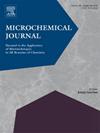A disposable electrochemical sensor for amyloid-β42 protein based on molecular imprinted polymers with nitrogen doped carbon dots-graphene nanohybrid
IF 4.9
2区 化学
Q1 CHEMISTRY, ANALYTICAL
引用次数: 0
Abstract
This work presented a molecularly imprinted polymer (MIP) electrochemical sensor for determination of amyloid-β42 (Aβ42) as an Alzheimer’s disease (AD) biomarker. A nitrogen-doped carbon-dot-graphene (NCD-G) nanohybrid was synthesized through a simple ultrasonic method. Polypyrrole (PPY) was used as an imprinted polymer with an Aβ42 template for the electropolymerization process. The NCD-G and MIP were modified on a screen-printed carbon electrode (SPCE) without binding agent. The morphology and electrochemical properties of MIP/NCD-G modified SPCE were studied by scanning electron microscopy (SEM), transmission electron microscopy (TEM), UV–Vis spectroscopy, X-ray photoelectron spectroscopy (XPS), cyclic voltammetry (CV) and square wave voltammetry (SWV). The developed sensor exhibited good linear response in a range from 5 to 70 pg/mL with a limit of detection (LOD) of 1 pg/mL under optimal conditions. This sensor shows excellent performance due to the enhancement of effective surface area, electrical conductivity, and electrocatalytic activity. This MIP sensor takes advantage of molecularly imprinted technique combined with nanohybrid to achieve high selectivity and sensitivity. Moreover, it possessed good reproducibility and miniaturization that could be applied as a platform for portable devices in healthcare in the future. This work provides the combination of a zero-dimensional and two-dimensional materials, nitrogen doped carbon dots-graphene nanohybrid (NCD-G) by self-assembly through a simple ultrasonication method and applied as a molecularly imprinted polymer (MIP) sensor for determination of amyloid-β42 protein. We propose a minimum number of preparation steps which NCD-G could enhance the MIP sensor performance, owing to the synergistic effects with high selectivity and sensitivity. The hybrid formation of the carbon dots with graphene using their π-π interactions in carbon nanostructures. NCD-G nanohybrid and MIP modified on screen printed carbon electrode (SPCE) for the determination of amyloid-β42 have not been previously investigated. Moreover, this disposable strip is a single-use tool that might be essential for on-site devices.基于分子印迹聚合物与掺氮碳点-石墨烯纳米杂化技术的淀粉样β42 蛋白一次性电化学传感器
本研究提出了一种分子印迹聚合物(MIP)电化学传感器,用于测定阿尔茨海默病(AD)生物标志物淀粉样蛋白-β42(Aβ42)。通过简单的超声波方法合成了氮掺杂碳点石墨烯(NCD-G)纳米杂化物。聚吡咯(PPY)被用作印迹聚合物,在电聚合过程中以 Aβ42 为模板。NCD-G 和 MIP 被修饰在不含结合剂的丝网印刷碳电极(SPCE)上。通过扫描电子显微镜(SEM)、透射电子显微镜(TEM)、紫外可见光谱、X 射线光电子能谱(XPS)、循环伏安法(CV)和方波伏安法(SWV)研究了 MIP/NCD-G 修饰的 SPCE 的形貌和电化学特性。在最佳条件下,所开发的传感器在 5 至 70 pg/mL 范围内表现出良好的线性响应,检测限(LOD)为 1 pg/mL。由于有效表面积、电导率和电催化活性的提高,该传感器表现出卓越的性能。这种 MIP 传感器利用分子印迹技术与纳米杂化技术相结合的优势,实现了高选择性和高灵敏度。此外,它还具有良好的可重复性和微型化特点,未来可用作医疗保健领域的便携式设备平台。本研究通过简单的超声波处理方法,将零维和二维材料--掺氮碳点-石墨烯纳米杂化物(NCD-G)--自组装结合起来,并将其作为分子印迹聚合物(MIP)传感器应用于淀粉样β42蛋白的检测。我们提出了一种最少制备步骤的方法,由于具有高选择性和高灵敏度的协同效应,NCD-G 可以提高 MIP 传感器的性能。利用碳纳米结构中的π-π相互作用使碳点与石墨烯形成杂化。用于测定淀粉样蛋白-β42 的 NCD-G 纳米杂化和 MIP 改性丝网印刷碳电极(SPCE)此前尚未进行过研究。此外,这种一次性条状电极是一种一次性工具,可能是现场设备所必需的。
本文章由计算机程序翻译,如有差异,请以英文原文为准。
求助全文
约1分钟内获得全文
求助全文
来源期刊

Microchemical Journal
化学-分析化学
CiteScore
8.70
自引率
8.30%
发文量
1131
审稿时长
1.9 months
期刊介绍:
The Microchemical Journal is a peer reviewed journal devoted to all aspects and phases of analytical chemistry and chemical analysis. The Microchemical Journal publishes articles which are at the forefront of modern analytical chemistry and cover innovations in the techniques to the finest possible limits. This includes fundamental aspects, instrumentation, new developments, innovative and novel methods and applications including environmental and clinical field.
Traditional classical analytical methods such as spectrophotometry and titrimetry as well as established instrumentation methods such as flame and graphite furnace atomic absorption spectrometry, gas chromatography, and modified glassy or carbon electrode electrochemical methods will be considered, provided they show significant improvements and novelty compared to the established methods.
文献相关原料
| 公司名称 | 产品信息 | 采购帮参考价格 |
|---|
 求助内容:
求助内容: 应助结果提醒方式:
应助结果提醒方式:


